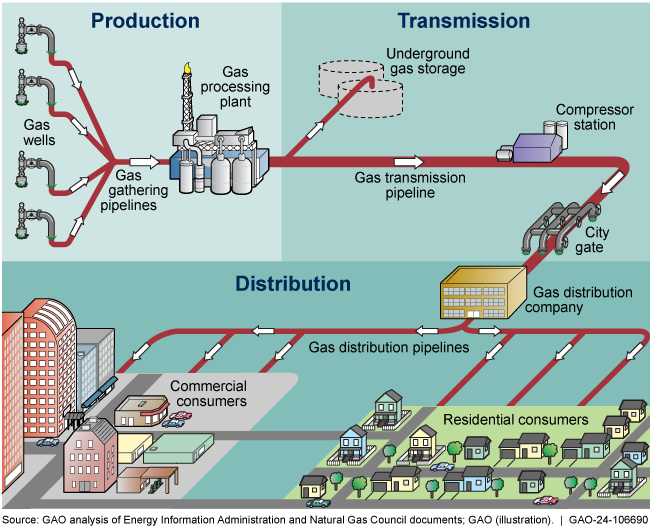Gas Pipeline Safety: Better Data and Planning Would Improve Implementation of Regulatory Changes
Fast Facts
About 300,000 miles of gas transmission pipelines cross the nation. Pipelines and related equipment failure can cause incidents of harm to people or property.
The Pipeline and Hazardous Materials Safety Administration recently issued rules to strengthen gas transmission safety regulations. Among other things, these rules require pipeline operators to assess more miles of pipeline than before and keep better records.
Our Q&A report found that the agency didn't have plans for implementing these rules—which could help pipeline operators improve incident assessment and mitigation.
Our recommendations are to address this and other issues we found.
Transmission Pipelines within a Natural Gas Pipeline System

Highlights
What GAO Found
The Department of Transportation's Pipeline and Hazardous Materials Safety Administration (PHMSA) sets the federal minimum safety standards for all gas transmission pipelines, including regulations for the risk-based integrity management program. Under integrity management regulations, pipeline operators must establish programs to assess, identify, and mitigate risks to pipelines in "high consequence areas," which may include areas with homes or schools, and other highly populated areas.
Operators can use two methods to identify high consequence areas. One of these methods calculates the potential impact radius of a pipeline incident. PHMSA officials told GAO the agency is considering regulatory changes to improve the accuracy of this method. However, GAO's analysis found that PHMSA lacks complete information from actual pipeline incidents that would help it determine if this method is accurate. Determining what additional data are needed from operators could improve the quality of PHMSA's data on pipeline incidents and assist the agency in evaluating the method's accuracy over time.
More broadly, PHMSA issued two final rules in October 2019 and August 2022 that strengthened gas transmission pipeline safety regulations. Among other changes, these rules require operators to assess additional pipeline mileage and improve pipeline characteristic data on their pipeline systems.
PHMSA has largely implemented the 2019 final rule by providing training to federal and state pipeline inspectors and guidance to the pipeline industry, among other activities. In addition, PHMSA established Final Rule Implementation web pages to improve access to related resources. Selected stakeholders GAO spoke with—including representatives from selected pipeline industry and safety groups, state regulatory officials, and gas transmission pipeline operators—identified key changes in the final rules that they expect will improve pipeline safety. However, stakeholders also told GAO they experienced challenges with PHMSA's implementation of the 2019 final rule, including the timeliness and clarity of related guidance.
PHMSA officials said they are in the process of implementing the 2022 final rule, and the effort is being led by the agency's new rule implementation division. PHMSA officials told GAO the agency does not have or intend to develop an implementation plan to guide its efforts. Instead, officials have completed several activities related to the 2022 final rule and created a task list of the remaining activities; however, GAO found that the document does not contain clear objectives, timelines, or communication strategies for these activities. By creating a plan for the remaining activities, PHMSA could better ensure that officials complete these activities in a timely manner and provide relevant information to the appropriate audiences.
In addition, GAO found that PHMSA's Final Rule Implementation web pages do not include complete information and guidance for both rules. With updated web pages, operators and inspectors may find information about the 2019 and 2022 final rules more accessible.
Why GAO Did This Study
About 300,000 miles of gas transmission pipelines across the United States carry products from processing facilities to communities and other large-volume customers. Pipelines are a relatively safe mode for transporting natural gas and other commodities, but incidents can still occur.
The Protecting our Infrastructure of Pipelines and Enhancing Safety Act of 2016 includes a provision for GAO to examine issues related to gas transmission integrity management programs and other pipeline safety topics following completion of a specific pipeline safety rulemaking by PHMSA. This report includes information on potential changes to the methods operators use to identify high consequence areas; how selected stakeholders, including pipeline operators and state inspectors, view the regulatory changes to gas transmission pipeline safety; and how PHMSA is overseeing the implementation of final rules completing this rulemaking.
Recommendations
GAO recommends that PHMSA (1) evaluate what additional data is needed from operators to better understand the actual impact of pipeline incidents, as the agency considers possible changes to the potential impact radius calculation, (2) develop a plan for the remaining activities to implement the 2022 final rule, and (3) update its Final Rule Implementation web pages to increase accessibility to information and guidance pertaining to the 2019 and 2022 final rules. The Department of Transportation concurred with our recommendations.
Recommendations for Executive Action
| Agency Affected | Recommendation | Status |
|---|---|---|
| Pipeline and Hazardous Materials Safety Administration | The Administrator of PHMSA should, as PHMSA considers possible changes to the potential impact radius calculation, evaluate what additional data are needed from operators to better understand the actual impact of pipeline incidents. (Recommendation 1) |
When we confirm what actions the agency has taken in response to this recommendation, we will provide updated information.
|
| Pipeline and Hazardous Materials Safety Administration | The Administrator of PHMSA should develop an implementation plan for the remaining activities for the 2022 final rule that includes clear objectives, timelines, and an outreach strategy. (Recommendation 2) |
When we confirm what actions the agency has taken in response to this recommendation, we will provide updated information.
|
| Pipeline and Hazardous Materials Safety Administration | The Administrator of PHMSA should update the 2019 and 2022 Gas Transmission Final Rule Implementation web pages to increase accessibility to rule implementation information. (Recommendation 3) |
When we confirm what actions the agency has taken in response to this recommendation, we will provide updated information.
|
